#Global Anti-aging Products
Explore tagged Tumblr posts
Text
Anti-Ageing Products Market Size, Share, Trends, Global Demand, Growth and Opportunity Analysis
Anti-Ageing Products Market report is an important manuscript for every market enthusiast, policymaker, investor, and market player. The market research and analysis conducted in this report assists clients in forecasting the investment in an emerging market, growth of market share or success of a new product. In addition, this business report endows with a delegate overview of the market where it identifies industry trends, determines brand awareness, potency and insights and provides competitive intelligence. Report contains strong and weak points of the competitors and analysis of their strategies with respect to product and industry. Anti-Ageing Products Market is the most established tool and hence used widely to generate market research report.
With the complete understanding of business environment that is best suitable for the requirements of the client, Anti-Ageing Products Market business report has been generated. Businesses can also achieve insights into profit growth and sustainability programs with this market report. Market drivers and market restraints explained in this report gives idea about the rise or fall in the consumer demand for the particular product depending on several factors. This market document contains all the company profiles of the major players and brands. Each of the topics is properly elaborated with the in-depth research and analysis for generating an absolute Anti-Ageing Products Market survey report.
The global anti-ageing products market was valued at USD 42.88 billion in 2021 and is expected to reach USD 67.83 billion by 2029, registering a CAGR of 5.90% during the forecast period of 2022-2029. In addition to the market insights such as market value, growth rate, market segments, geographical coverage, market players, and market scenario, the market report curated by the Data Bridge Market Research team includes in-depth expert analysis, import/export analysis, pricing analysis, production consumption analysis, and consumer behavior.
Access Full 350 Pages PDF Report @
Anti-Ageing Products Key Benefits over Global Competitors:
The report provides a qualitative and quantitative analysis of the Anti-Ageing Products Market trends, forecasts, and market size to determine new opportunities.
Porter’s Five Forces analysis highlights the potency of buyers and suppliers to enable stakeholders to make strategic business decisions and determine the level of competition in the industry.
Top impacting factors & major investment pockets are highlighted in the research.
The major countries in each region are analyzed and their revenue contribution is mentioned.
The market player positioning segment provides an understanding of the current position of the market players active in the Personal Care Ingredients
Table of Contents: Anti-Ageing Products Market
1 Introduction
2 Global Anti-Ageing Products Market Segmentation
3 Executive Summary
4 Premium Insight
5 Market Overview
6 Anti-Ageing Products Market, by Product Type
7 Anti-Ageing Products Market, by Modality
8 Anti-Ageing Products Market, by Type
9 Anti-Ageing Products Market, by Mode
10 Anti-Ageing Products Market, by End User
12 Anti-Ageing Products Market, by Geography
12 Anti-Ageing Products Market, Company Landscape
13 Swot Analysis
14 Company Profiles
Critical Insights Related to the Anti-Ageing Products Included in the Report:
Exclusive graphics and Illustrative Porter’s Five Forces analysis of some of the leading companies in this market
Value chain analysis of prominent players in the market
Current trends influencing the dynamics of this market across various geographies
Recent mergers, acquisitions, collaborations, and partnerships
Revenue growth of this industry over the forecast period
Marketing strategy study and growth trends
Growth-driven factor analysis
Emerging recess segments and region-wise market
An empirical evaluation of the curve of this market
Ancient, Present, and Probable scope of the market from both prospect value and volume
Some of the major players operating in the anti-ageing products market are
Shiseido Company (Japan)
Johnson & Johnson Private Limited (India
Unilever (U.K.)
Amway (U.S.)
Procter & Gamble (U.S.)
L’Oréal S.A. (France)
Revlon Group (U.S.)
Beiersdorf AG (Germany)
Natura & CO (South America)
Conair Corporation (U.S.)
Yves Rocher (France)
Kao Corporation (Japan)
Estée Lauder Companies Inc. (U.S)
AVON PRODUCTS (U.K.)
OLAPLEX (U.S.)
NEOSTRATA COMPANY, INC. (U.S.)
Browse Trending Reports:
Archery Equipment Market Size, Share, Trends, Growth and Competitive Analysis https://www.databridgemarketresearch.com/reports/global-archery-equipment-market
Towel Warmers Market Size, Share, Trends, Growth Opportunities, Key Drivers and Competitive Outlook https://www.databridgemarketresearch.com/reports/global-towel-warmers-market
Cork Flooring Market Size, Share, Trends, Growth Opportunities and Competitive Outlook https://www.databridgemarketresearch.com/reports/global-cork-flooring-market
Premium Motorcycle Helmets Market Size, Share, Trends, Key Drivers, Growth and Opportunity Analysis https://www.databridgemarketresearch.com/reports/global-premium-motorcycle-helmets-market
Multicooker Market Size, Share, Trends, Key Drivers, Demand and Opportunity Analysis https://www.databridgemarketresearch.com/reports/global-multicooker-market
About Data Bridge Market Research:
Data Bridge set forth itself as an unconventional and neoteric Market research and consulting firm with unparalleled level of resilience and integrated approaches. We are determined to unearth the best market opportunities and foster efficient information for your business to thrive in the market. Data Bridge endeavors to provide appropriate solutions to the complex business challenges and initiates an effortless decision-making process.
Contact Us:
Data Bridge Market Research
US: +1 888 387 2818
UK: +44 208 089 1725
Hong Kong: +852 8192 7475
Email: [email protected]
#Anti-Ageing Products Market Size#Share#Trends#Global Demand#Growth and Opportunity Analysis#market research#market trends#market analysis#market share#marketreport#market report#market size#marketresearch#markettrends
0 notes
Text
☆˙˖ DESIRED REALITY !

things i script for my modern dr. lmk if you want more
⬭ racism, homophobia, ableism, transphobia, islamophobia, anti semitism, misogyny, global warming, climate change, overconsumption, overpopulation, deforestation, habitat destruction etc., used to exist, however they currently do not and will never suffer from them again.
⬭ everyone is treated equal
⬭ no “pro-life”
⬭ people are allowed to have abortions no matter what age they are
⬭ women products are free such as pads/tampons and birth control
⬭ everyone is educated on problems happening around the world
⬭ health care is free
⬭ natives are seen as the founders of America
⬭ south, west, southeast, & central Asians are seen too + people know Asia is not just the east
⬭ having guns are illegal unless your job requires you to have one and there is no other way to get a gun
⬭ periods last a day and are very light
⬭ covid-19 doesn’t exist
⬭ plastic surgery is normalized , isnt look down on but people rarely gets it unless necessary
⬭ children of any age are not sexualized in any form or shape
⬭ in public bathrooms the toilet is always clean, people don't knock on the stall you are in, there is always toilet paper, always soap and a hand dryer
⬭ the Chinese government isn't so harsh & gives the citizens freedom
⬭ people of color’s cultures are RESPECTED, & not appropriated
⬭ foster care takes treats kids nicely
⬭ nobody harms animals and kill shelters are not a thing
⬭ all country leaders are good and honest people
⬭ human trafficking does not exist
⬭ the government never watches you through your phone
⬭ trump never ran for president
⬭ no world hungers
⬭ no one is homeless, and everyone has a home
⬭ world peace
⬭ women and men are equal
⬭ it’s easy for people to make money
⬭ all sickness has a cure
⬭ bullying does not exist
⬭ black history and pride month still exist
⬭ the government isn't greedy and take care of their people
⬭ every country has money, food, isnt poor, etc. etc.
⬭ no toxic parenting
⬭ the Sewol ferry never had an accident
⬭ school shooting doesn’t exist
⬭ minimum wage is $15-$20 an hour
⬭ crimes are punished with justice in mind
⬭ history is recorded correctly
⬭ people can start driving at 15
⬭ Korea is not conservative
⬭ Korea doesn’t have an unrealistic beauty standard
⬭ Korea never divided, it is united and free. But south of korea is like the city part and the north is like rural part
⬭ pollution does not exist
⬭ earth air is clean and easy to breathe no matter where you are
⬭ no acid rain, urban sprawl, ozone layer depletion
⬭ allergies do not exist
⬭ the world is more colorful and not dull looking
⬭ coral reef still has it color
⬭ no water in unwanted places
⬭ grass is always green
⬭ if the population increases the planet gets bigger to produce resources to accommodate the growing population. it doesnt effect the mass of the earth or the gravitational pull
⬭ global warming doesn't exist
⬭ humidity doesn't ruin hair
⬭ the library of alexandria was never destroyed
⬭ apple pencils work on iPhone
⬭ everything is wireless, and nothing needs a cord
⬭ line is always short in stores and restaurants
⬭ buildings and renovating don’t take longer than a wee
⬭ you can book a hotel with being 18 or older
⬭ traffic is always fine
⬭ netflix have more of a large selection of things and dont remove shows/add shows no one wants
⬭ spotify is free
⬭ the switch have a web browser
⬭ tv companies still make tv shows similar to the 2000s and early 2010s , just updated to keep up with the times
⬭ the sims franchise lore is linear throughout the series
the open world features from sims 3 is still present in sims 4
sims 4 is like an updated and better version of sims 3 keeping all the features from the sims 3 (still including everything that is already in sims 4)
non of the games have bugs
every expansion pack etc is just added to the game as an update and no one has to pay for it
⬭ cheap jewelry doesnt tarnish
⬭ washer/dryer cycles are 15 mins
⬭ in the show dancing dolls everyone was treated equally and was never fake to each other.
⬭ people actually do the theme for the met gala and it’s always unique
୨୧⠀˙⠀⠀˖⠀ world aesthetic & vibe


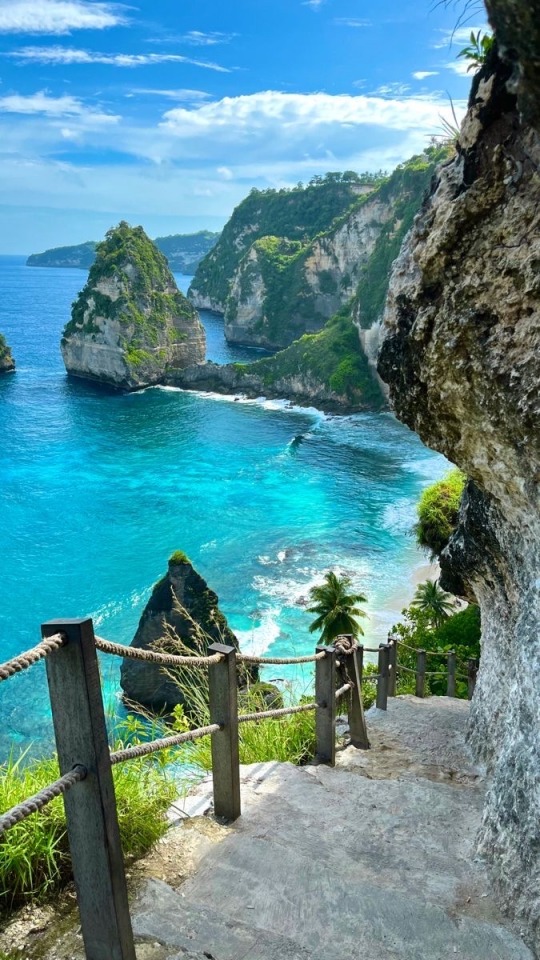
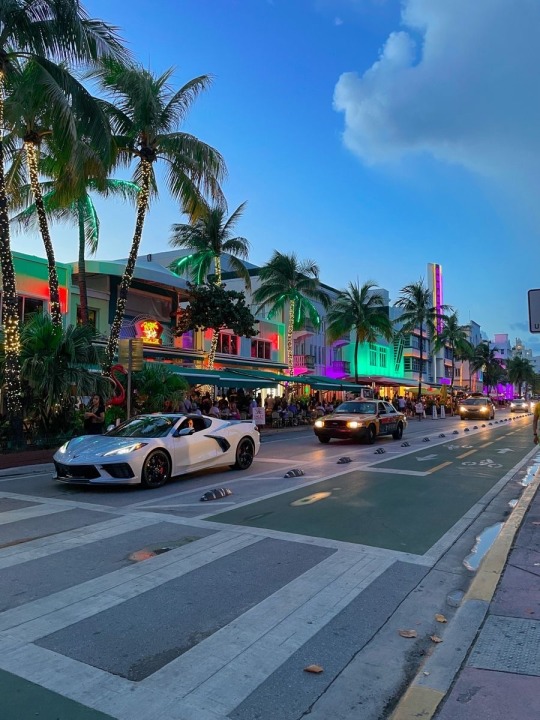
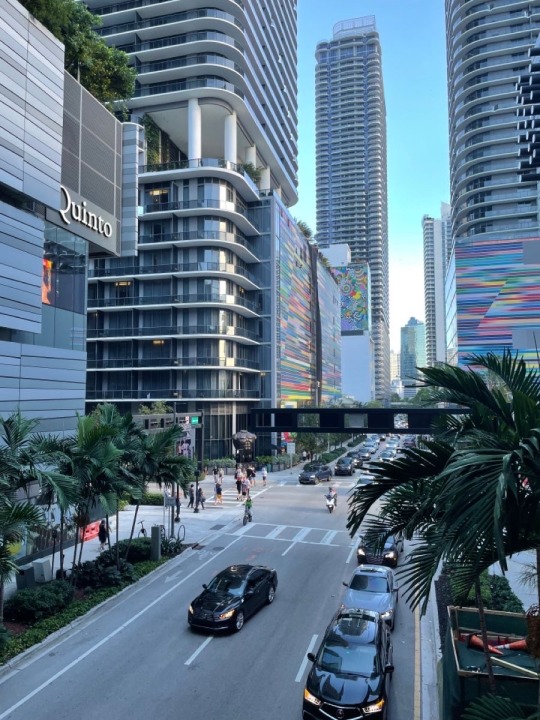

#𓏸𓈒 — YANA#★ DA BRAT DRS#scripting ideas#script#reality shifting#shifting#desired reality#manifesation#things to script#shifting script#shifting community#shiftblr#shifters#shifting motivation#shifting realities
376 notes
·
View notes
Text
The unexpected upside of global monopoly capitalism

I'm touring my new, nationally bestselling novel The Bezzle! Catch me TODAY (Apr 10) at UCLA, then Chicago (Apr 17), Torino (Apr 21) Marin County (Apr 27), Winnipeg (May 2), Calgary (May 3), Vancouver (May 4), and beyond!

Here's a silver lining to global monopoly capitalism: it means we're all fighting the same enemy, who is using the same tactics everywhere. The same coordination tools that allow corporations to extend their tendrils to every corner of the Earth allows regulators and labor organizers to coordinate their resistance.
That's a lesson Mercedes is learning. In 2023, Germany's Supply Chain Act went into effect, which bans large corporations with a German presence from using child labor, violating health and safety standards, and (critically) interfering with union organizers:
https://www.bafa.de/EN/Supply_Chain_Act/Overview/overview_node.html
Across the ocean, in the USA, Mercedes has a preference for building its cars in the American South, the so-called "right to work" states where US labor law is routinely flouted and unions are thin on the ground. As The American Prospect's Harold Meyerson writes, the only non-union Mercedes factories in the world are in the US:
https://prospect.org/labor/2024-04-08-american-workers-german-law-uaw-unions/
But American workers – especially southern workers – are on an organizing tear, unionizing their workplaces at a rate not seen in generations. Their unprecedented success is down to their commitment, solidarity and shrewd tactics – all buoyed by a refreshingly pro-worker NLRB, who have workers' backs in ways also not seen since the Carter administration:
https://pluralistic.net/2023/09/14/prop-22-never-again/#norms-code-laws-markets
Workers at Mercedes' factory in Vance, Alabama are trying to join the UAW, and Mercedes is playing dirty, using the tried-and-true union-busting tactics that have held workplace democracy at bay for decades. The UAW has lodged a complaint with the NLRB, naturally:
https://www.commondreams.org/news/alabama-mercedes-benz
But the UAW has also filed a complaint with BAFA, the German regulator in charge of the Supply Chain Act, seeking penalties against Mercedes-Benz Group AG:
https://uaw.org/uaw-files-charges-in-germany-against-mercedes-benz-companys-anti-union-campaign-against-u-s-autoworkers-violates-new-german-law-on-global-supply-chain-practices/
That's a huge deal, because the German Supply Chain Act goes hard. If Mercedes is convicted of union-busting in Alabama, its German parent-company faces a fine of 2% of its global total revenue, and will no longer be eligible to sell products to the German government. Chomp.
Now, the German Supply Chain Act is new, and this is the first petition filed by a non-German union with BAFA, so it's not a slam dunk. But supermajorities of Mercedes workers at the Alabama factory have signed UAW cards, and the election is going to happen in May or June. And the UAW – under new leadership, thanks to a revolution that overthrew the corrupt old guard – has its sights set on all the auto-makers in the American south.
As Meyerson writes, the south is America's onshore offshore, a regulatory haven where corporations pay minimal or no tax and are free to abuse their workers, pollute, and corrupt local governments with a free hand (no wonder American industry is flocking to these states). Meyerson: "The economic impact of unionizing the South, in other words, could almost be placed in the same category as reshoring work that had gone to China."
The German Supply Chain Act was passed with the help of Germany's powerful labor unions, in an act of solidarity with workers employed by German companies all over the world. This is that unexpected benefit to globalism: the fact that Mercedes has extrusions into both the American and German political spheres means that both American and German workers can collaborate to bring it to heel.
The same is true for antitrust regulators. The multinational corporations that are in regulators' crosshairs in the US, the EU, the UK, Australia, Japan, South Korea and beyond use the same playbook in every country. That's doubly true of Big Tech companies, who literally run the same code – embodying the same illegal practices – on servers in every country.
The UK's Competition and Markets Authority has led the pack on convening summits where antitrust enforcers from all over the world gather to compare notes and collaborate on enforcement strategies:
https://www.eventbrite.co.uk/e/cma-data-technology-and-analytics-conference-2022-registration-308678625077
And the CMA's Digital Markets Unit – which boasts the the largest tech staff of any competition regulator in the world – produces detailed market studies that turn out to be roadmaps for other territories' enforces to follow – like this mobile market study:
https://assets.publishing.service.gov.uk/media/63f61bc0d3bf7f62e8c34a02/Mobile_Ecosystems_Final_Report_amended_2.pdf
Which was extensively referenced in the EU during the planning of the Digital Markets Act, and in the US Congress for similar legislation:
https://www.congress.gov/bill/117th-congress/senate-bill/2710
It also helped enforcers in Japan:
https://asia.nikkei.com/Business/Technology/Japan-to-crack-down-on-Apple-and-Google-app-store-monopolies
And South Korea:
https://www.reuters.com/technology/skorea-considers-505-mln-fine-against-google-apple-over-app-market-practices-2023-10-06/
Just as Mercedes workers in Germany and the USA share a common enemy, allowing for coordinated action that takes advantage of vulnerable flanks wherever they are found, anti-monopoly enforcers are sharing notes, evidence, and tactics to strike at multinationals that are bigger than most countries – but not when those countries combine.
This is an unexpected upside to global monopolies: when we all share a common enemy, we've got endless opportunities for coordinated offenses and devastating pincer maneuvers.

If you'd like an essay-formatted version of this post to read or share, here's a link to it on pluralistic.net, my surveillance-free, ad-free, tracker-free blog:
https://pluralistic.net/2024/04/10/an-injury-to-one/#is-an-injury-to-all
#pluralistic#monopoly#labor#nlrb#germany#harold meyerson#supply chain act#right to work#onshore offshore#uaw#vance alabama#vance#alabama#bafa#mercedes#antitrust#trustbusting
706 notes
·
View notes
Text
The near future in the Doctor Who universe sure gets dire doesn't it? Especially if Mad Jack / Roger ap Gwilliam is still part of history.
I thought I'd have a bit of fun listing things out, combining as many sources as possible. Turns out he fits in shockingly well with what we know. There's a lot missing here or cut out, and for obvious reasons it's very UK / Europe focused, but nonetheless:

[ID: Scene from The Christmas Invasion showing Harriet Jones on BBC News. The news ticker reads "PM HEALTH SCARE", "Unfit for duty?", and references a "SECRET GOVERNMENT MOLE" and a quote: "BLOOD ON [HER HANDS]".]
2006-2021 (obviously the past now, but still noting for the resulting temporal and political butterfly effect) - In the original timeline, Harriet Jones remains Prime Minister for 3 consecutive terms, presumably 15 years assuming no snap election was called, referred to as a 'golden age' [World War Three]. The Tenth Doctor deliberately changes history to cause her deposal [The Christmas Invasion], leading to numerous disastrous terms in the meantime, including those of Harold Saxon [The Sound of Drums et al.], Brian Green (who tried to appease the 456) [Children of Earth], Boris Johnson (an auton host of the Nestene Consciousness) [Rose (novelisation)], and Jo Patterson (responsible for deploying cloned Dalek defence drones in the UK's streets) [Revolution of the Daleks].

[ID: Scene from Revolution of the Daleks. A 'defence drone' Dalek is used to support anti-riot police in a test, dispersing protestors with mock tear gas.]
2010s-2030s - The European Union gradually integrates further, eventually becoming the European Zone / Eurozone, a global superpower which competes with the USA through the 21st century. The UK eventually forms part of the bloc [Trading Futures].
It's likely that Harriet Jones's deposal led to this and related events being delayed or erased, with Brexit (driven by, among others, one of Jones's successors in the new timeline) reducing european unity. Most notably, Ramón Salamander's rise to power occurs now not in the 2010s [The Enemy of the World], but in the 2030s [Doctor Who and the Enemy of the World]. There are other events that are seemingly delayed by ~20 years by changes to the timeline, including future events like the dictatorship of Mariah Learman [The Time of the Daleks, Trading Futures], and yet also possibly past events like the death of Queen Elizabeth II [Battlefield, The Longest Night et al.], which may suggest something else (eg. the Time War) may be responsible.
~2030 - During a time of rising global tensions [73 Yards], Ramón Salamander convinces a group of scientists in an underground shelter endurance experiment that nuclear war has broken out on the surface. They are convinced to generate artificial "natural" disasters to fight back against the enemy. Between this and ongoing climate change, several global food sources collapse as a result, including Canada and Ukraine's corn and flour production [The Enemy of the World].
2031 - Tensions culminate in the "Great Russian War". Despite posturing, not a single nuclear weapon is fired, at least by NATO [73 Yards]. This may be later considered World War III [Trading Futures].
~2032-2035 - Following the war, tensions rise again, now between the Eurozone and the USA [Trading Futures], possibly in reaction to actions (or lack thereof?) taken by NATO during the war [73 Yards]. Both send separate peacekeeping forces to conflict in North Africa. Meanwhile, Italy is engaged in civil war [Trading Futures].

[ID: Scene from The Enemy of the World, showing Ramón Salamander.]
Over the decade, Ramón Salamander rises in power in the World Zone Authority, using his patented "Sun Store" satellite technology to aid the growth of crops by controlling sunlight over agricultural regions. In the background, he murders and blackmails officials to place loyalists into powerful positions, with the goal of ruling over the World Zone Authority as a dictator. Salamander's treachery is later discovered and he disappears [The Enemy of the World].
2037 - 2042 - Several militia declare wars of Independence from the USA. Notably, Phoenix, Arizona is destroyed in a terrorist attack. While the country largely persists after the conflicts, some territories seem to successfully secede - with, for example, a Montana Republic seemingly being in existence in 2054 [Alien Bodies].
2038 - The World Zones Accord is signed. This is later considered to have reduced the United Nations to a 'joke' compared with the World Zone Authority [Alien Bodies]. Given the extensive power it gives to the WZA, this was likely originally part of Salamander's plan, but due to his disappearance he is not around to reap the rewards [The Enemy of the World].
2039 - A group of Mexican astronauts studying minerals on the Moon go missing [Kill the Moon].
~2030s - 2040s - The Earth begins to experience major climate change effects, including "appalling storm conditions" which harm agriculture [The Waters of Mars]. The ice caps melt and flood much of the Earth [K9] with nations like the Netherlands ending up entirely flooded [St Anthony's Fire]. Some regions experience corrosive acid rain [Cat's Cradle: War Head, Strange Loops]. One summer sees Britain experience a 22 week drought. At this time, the Eurozone closes its borders to millions of North African and Baltic Sea refugees [Hothouse]. This time period may be known as the "Oil Apocalypse" [The Waters of Mars].

[ID: Scene from K9 Episode 13: Aeolian. Big Ben stands in the middle of a colossal storm of wind and rain.]
With Earth's ecosystems collapsing [Davros], humanity begin to realise it's facing extinction [The Waters of Mars]. An artificial cooling agent is spread in the atmosphere to semi-successfully combat the effects, but leads to dramatic side-effects, including freezing some areas of the globe. This is known as the "Great Cataclysm" [K9].
2041 - A three-human team, including Adelaide Brooke, lands on Mars for the first time [The Waters of Mars]. However, with this accomplishment, and increasing turbulence on Earth, Humanity gradually loses interest in space exploration [Kill the Moon].
Before 2045 - Around this time, the UK falls into a dictatorship ruled by the "Director", head of a military council that has allegedly (secretly?) controlled the government since 2028 [Britain Protests]. It is possible that this Director was previously the "Minister of War" for previous governments [Before the Flood].
2045 - The World Zones Authority evolves into a World Government, with Nikita Bandranaik being elected President. The UK is not part of the organisation [This is 2065].
2046-2050s - The Director is overthrown [Down with the Director] and the rest of the government "collapses in shame" [73 Yards]. Some of the revolutionaries celebrate now being "masters of [their] own country" [Down with the Director]. Despite the hopes of the World Government for international integration, this nationalistic streak continues.

[ID: Scene from 73 Yards. Roger ap Gwilliam, with an Albion Party ribbon on his chest declares victory on BBC News, live from Kennington High in London. Headline reads "LANDSLIDE VICTORY FOR ALBION PARTY: Majority of 92 predicted. Roger ap Gwilliam declared Prime Minister."]
Roger ap Gwilliam is elected Prime Minister, with the far-right nationalistic Albion Party gaining a majority of 92 MPs [73 Yards]. While his government does take the step to officially join the World Government senate [Down with the Director], he seeks greater independence from other nations. One of his first actions is to expand the UK's nuclear arsenal, purchasing missiles from Pakistan and withdrawing from NATO. In his term, the world is brought to the brink of nuclear war [73 Yards], likely in the pre-2050s "Euro Wars" [The Time of the Daleks].
In this time, the "Department", a (private?) multinational security organisation is born, based primarily in the UK. They gain broad powers, which they use to control populations with propaganda and use of "CCPC"s: robotic law enforcement notorious for their surveillance and brutality. Despite its recent revolution, the country is rendered practically a police state [K9].

[ID: Scene from K9 Episode 1: Regeneration. CCPCs, hulking police robots, march down a dark alley.]
2049 - The Moon starts to dramatically gain mass, causing massive tides on the Earth, flooding entire cities. In a last ditch at survival, humanity plans to try and destroy the Moon using an array of nuclear bombs. Despite the people of Earth being offered the vote on what to do by turning off their lights, it appears the decision is made on a national level, with lights going off grid-by-grid. Nonetheless, the Moon is allowed to hatch, leaving behind a new less massive egg "moon" with minimal further destruction [Kill the Moon].

[ID: Scene from Kill the Moon. The Moon hatches in the background, as the TARDIS stands by the sea.]
Humanity's interest in space exploration returns [Kill the Moon], starting a new space race. Among these projects, Australia begins constucting a space elevator, Spain a project called "SpaceLink", while Germany and Russia each begin a series of new Moon missions. The Philippines are rumoured to be planning their own landing on Mars [The Waters of Mars].
~2050 - The UK Government (ap Gwilliam's?) is couped once more, by General Mariah Learman. With the King's permission, elections are suspended for at least a couple years, with her ruling over a "benevolent dictatorship". She is later abducted and forcibly mutated by the Daleks [The Time of the Daleks]. Despite the previous description, her promotion of Shakespeare in schools is remembered as the only good thing about her rule [Trading Futures]. (Note: As mentioned prior, it's likely that Learman's rule may have been delayed as Salamander's was. This is suggested by the mention of her in Trading Futures, set seemingly ~2030s or earlier, despite The Time of the Daleks taking place around the 2050s.)
~2050s - The Gravitron is built on the new Moon. This is used to artificially control the tides and weather [The Moonbase]. It likely also is intended to study and monitor the new Moon for future changes [Kill the Moon].

[ID: Scene from The Moonbase, giving an external shot of the base.]
2058 - 2059 - Bowie Base One is established: humanity's first colony on another planet and an international collaboration between the UK, USA, Russia, Germany, Turkey, South Korea, Lithuania, Australia, and Pakistan. One year later, it is mysteriously destroyed in a deliberately triggered nuclear explosion. In the original timeline, there were no survivors. However, after the interference of the Time Lord Victorious, the true story is eventually told on Earth. Regardless "a veil of darkness" sweeps over the planet over the next few years. [The Waters of Mars], as international tensions heat up once more... [Total Eclipse of the Heart].
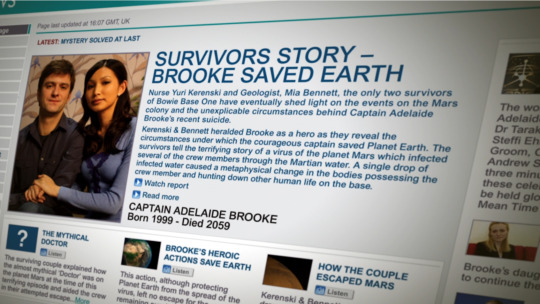
[ID: Scene from The Waters of Mars, showing an internet news website. Various articles appear focused on the Bowie Base One incident, including "SURVIVORS STORY - BROOKE SAVED EARTH", "THE MYTHICAL DOCTOR", "BROOKE'S HEROIC ACTIONS SAVE EARTH", and "HOW THE COUPLE ESCAPED MARS". The feature image shows the two survivors: Yuri Kerenski and Mia Bennett.]
2060s - The "Great War" breaks out on Earth, involving every country on Earth. This is likely World War IV. Details are vague, but it ultimately ends in a ceasefire, when it's realised the conflict is risking Earth's habitability [Total Eclipse of the Heart].
338 notes
·
View notes
Text
Reference saved in our archive
An interesting preprint showing that even if we are somehow wrong about masking against covid, protecting ourselves from pollutants and smoke improves our general immune health. Mask up. Stay safe out there.
Abstract Background: Wildfires are increasingly common with wildfire smoke affecting millions globally, yet its impact on immune responses is poorly understood. Natural Killer (NK) cells play a role in mediating air pollutant effects and regulating vaccine immunity. Objective: This real-world study, conducted on participants in the Pfizer BNT162b2 COVID-19 vaccine trial, studied the effects of wildfire smoke exposure on long-term vaccine effects. Methods: We collected blood samples from 52 healthy, non-smoking participants (ages 26-83) before and 1 month after placebo or vaccine injections during heavy wildfire smoke events in Sacramento. The study included 28 vaccinated (Group 1) and 24 placebo-injected (Group 2) individuals, the latter vaccinated several months later, outside wildfire season. Blood samples from both Group 1 and 2 were also investigated 6 months after the second dose of vaccine. We analyzed intracellular cytokines, B and NK cell markers by flow cytometry, and serum immunoglobulin levels against common coronaviruses using multiplex assays. Results: A robust S-RBD-specific IgG response observed 1 month post booster, declined variably 6 months later. Wildfire smoke acutely increased IL-13 expression by CD56bright NK cells. IL-13+CD56bright NK cells at the time of vaccination negatively correlated with anti-S-RBD IgG (r=-0.41, p<0.05) one month later. Total IgG levels on the other hand, positively correlated with the air quality index (AQI) measured during vaccination (r=0.96, p<0.01). Similarly to age (but not sex, BMI or race/ethnicity), the two-week AQI averages during vaccination showed a significant negative correlation with anti-S-RBD IgG levels 6 months later (r=-0.41, p<0.05). Conclusion: Wildfire smoke may lead to inappropriate immunoglobulin production and diminished vaccine immunity. Our novel findings highlight a previously unrecognized pathway involving NK-cell derived IL-13 and non-specific B-cell activation and underscore the significance of environmental exposures in shaping immunity.
#mask up#covid#pandemic#public health#wear a mask#covid 19#wear a respirator#still coviding#coronavirus#sars cov 2
44 notes
·
View notes
Text
the zenith of antisemitism: the Samson Option conspiracy and western foreign policy
as much as antisemitism is based in old tropes that took off with the diaspora in europe, esp during the middle ages, it is important to keep up with the new iterations of old conspiracies. not every piece of antisemitism is as consequential in scale - some things are local, others are regional; others are unprecedented and global.
lately and since oct 7th, antizionism is becoming the main productive engine of antisemitism because through western disinformation and propaganda, islamic-country apologists of terror and jihad can use the western progressive movements to dress up antisemitism in the rhetoric of anticolonialism, anti-liberalism, anti-imperialism.
then, these movements do the exact opposite of the values they purport, promoting islamofascism, arab imperialism and theocracy - economically and through international institutions (like UNRWA and the ICC) - these groups seek first and foremost to hurt israelis. as a side-effect, it also makes western jews and israelis more reactionary, from xenophobic trauma reactions and personal/demographic isolation. even the internet is becoming a place of 'online ghettos'.
the jewish democracy is held to a double standard that dehumanizes jews among any other group of people. every human group can have a national existence, but jews. every human group can have a religion or patriotism while being loyal to a republic, but jews. when it is the most vulnerable, the antisemites attacks grow more vicious. when jews and israelis are stronger, they play dumb and harmless.
antisemitism surges when jewish populations are in peril or literally hostage to a sworn enemy. when "ceasefire" becomes, 'keep the hostages', full-out war becomes the only existential choice, but at the same time war is demonized as aggression.
an old enemy rises too. in america, the country with the largest christian population, the christian right with white nationalist and christofascist groups (both protestant and catholic) are more than willing to take advantage of this moment of confusion and plausible deniability, with the left having normalized 'anti-zionist' slurs.
they are now doing so by accusing israel of plotting to nuke not iran or palestine, but the west, in line with canards of jewish power in government and 'double loyalties'. phrases like "israel first" are used to describe the establishment by right-wing groups that are no longer that fringe.
The Sampson Option refers to a strategy attributed to Israel, where, in the event of an existential threat or imminent destruction, Israel would retaliate with its nuclear arsenal, causing catastrophic damage not only to its enemies but potentially risking global repercussions. The term is derived from the biblical story of Samson, who, in his final act, brought down the pillars of a Philistine temple, killing himself and his enemies.
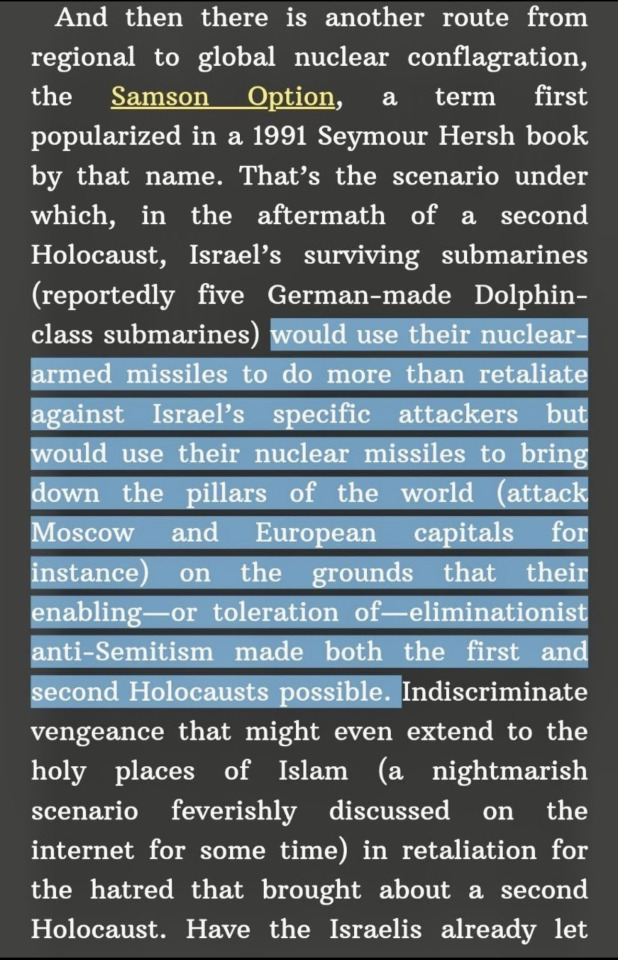
why? why does anyone say an enemy is going to destroy them first?
well, to justify obliteration. not of israel but of "zionists", of course. obviously so that (left-leaning) western governments can become persuaded to cripple israel first, and to cripple it hard (economically, militarily, technologically), and to tolerate first deplatforming 'zionist support' and ultimately, down the line, marginalizing the jewish identity in politics.
i.e. it is not the world/"us" (americans, westerners, the international institutions) that conspire against jews - it is jews that conspire against the entire world - this is the ultimate form of the antisemitic canard in the nuclear era, before the shadow of wwiii
genocide of jews becomes "self-defense". this is the zenith of antisemitism in human history. something that has no precedent, the ultimate form of holocaust reversal conspiracy aimed to have the international community not just exclude but fight israel and, ultimately, neutralize jewish agency altogether.
9 notes
·
View notes
Text
Gigabash character overview: Gigaman
You probably saw this one coming since I’ve repeatedly emphasized the importance of Ultraman for inspiration when Passion Republic Games was making Gigabash, it only made sense they’d make their own Ultraman! With all the fun cheesiness that comes with it.
youtube
Gigaman is the combo heavy speedster of the roster, with quick flurries of punches and great combo potential. He also has a few aerial moves as well, making his anti-air game really good. Gigaman also has a block breaking punch that can stun opponents as well. His single ranged attack can bounce off of buildings, and ricochet several times. It helps that he deals reduced damage to buildings as well (destruction of public property isn’t a good image for a hero after all), meaning those buildings stay around longer, so use them while they’re still around!.
Something fun about his ultimate is that if you don’t hit any buildings when you use it you can hear a crowd of people cheering you on, so don’t hit public property if you want to keep your fans happy!
Design
In some ways there isn’t much to talk about. I mean Gigaman is an Ultraman expy. He does have a few specific references though.
One of his skins is named Multi-Type, a reference to Ultraman Tiga, and another skin is yet another reference to Ultraman Belial.


Gigaman also has a dad bod, and this is because he actually was retired for 8 years but suddenly came back in modern day, so he’s let himself go a bit and age is catching up to him. But I think he’s still got it. One of his skins depicts him in his prime.
Here’s some concept art. I think my favorite is the shirtless one with G plastered on his face, it’s so stupid looking.

Lore
Gigaman is very secretive over who he is so let’s cover what we do know before getting to the implied stuff.
Around the 80’s a teenage Gigaman would make his first appearance in the San'ya district of Tokyo to defend it from a kaiju. And for around 30 years, up until 2012, he would defend Japan against monsters. This also meant that Japan didn’t need to rely on the Global Titan Defense Initiative.
Gigaman made sure that people were safe… and that he entertained them while he was at it. Every single time he appeared he brought something new to the table; a new technique, catchphrase, or move. Every time he showed up it was exciting. While he definitely liked the attention, he primarily did it all to spread hope to people. Showing that underneath all his showmanship, Gigaman is truly a humble dude.
Of course, when the person defending your country from monsters is a 132 foot superhero who likes posing for the camera, it’s understandable that there might be fanaticism. Indeed, there was a time when Japan was overflowing with “Gigamania” and a movie called “Rise of Gigaman” was even in production during this period.
Eventually though Gigaman would retire in 2012. He was getting around middle age at that point, and he couldn’t keep fighting kaiju forever. But this didn’t last long, and in 2021 he would come out of retirement to help the world deal with the new rise in kaiju activity.
Few other things to note are that Gigaman’s power is tied to the Giga Core and he personally knows Dr. Otama Kazuo, and even knows the inner workings of Thundatross, meaning he was present for its development.


So… is Gigaman a human who can transform into a kaiju, or a humanoid kaiju who can speak and understand technology and culture? There is some implication that it might be the former. His lore files follow a reporter trying to uncover his identity and his findings led him to the San'ya district and eventually Kamikuzu Orphanage, which was packed with orphans at the start of the first kaiju crisis in the 70’s. Sadly only a few were ever actually selected to receive formal education. There was one kid named “Sho” though, who was a big Gigaman fan and skipped class whenever he appeared. It’s possible that Gigaman is this “Sho” but there’s no confirmation. Sho would probably be in his 50s by now, and presumably so is Gigaman. Also I’m wondering, did Dr. Otama grow up in the same orphanage?
Sadly there wasn’t much to talk about this time, but I think we can all appreciate Japan’s masked hero. He’s certainly the first to come to my mind when people say “Ultraman expy”!

8 notes
·
View notes
Text
The growing trend of children as young as eight using skincare products could leave them with irreversible skin problems, the British Association for Dermatologists has warned.
Some children are asking their parents for luxury items after seeing them used by their favourite influencers on platforms such as YouTube and TikTok.
But many of these contain potentially harmful active ingredients intended for adults only, such as exfoliating acids.
They can provoke allergies or eczema.
Eight-year-old Sadie first saw skincare videos on TikTok, where influencers would talk about "how good they were on the skin".
She was particularly attracted to a product from the company Bubble, which "when you push down, comes up in [the shape of] a flower", she tells BBC News, and US brand Drunk Elephant because "she liked the packaging a lot" and it sold everything from lip balms to moisturisers.
BBC News has also received messages from several parents worried about their child's interest in skincare - and the influence of social media and friends.
With its bright colourful packaging and cartoon-animal logo, Drunk Elephant is one of the brands most frequently featured in adult and child influencers' online skincare content.
But many of its bestsellers, which cost about £60 each, contain exfoliators such as alpha and beta hydroxy acids and vitamin-A derivative retinol.
Skincare content is unrestricted on social media and many daily-routine and get-ready-with-me videos attract millions of views.
One skincare YouTuber has collated several from TikTok, showing children using harmful products.
'Stay away'
Other content creators have visited beauty stores - as workers at Sephora and US-based Ulta say children frequently abuse in-store testers and clear shelves of products as soon as they come into stock.
Drunk Elephant in particular has become so popular founder Tiffany Masterson has had to tell "kids and tweens stay away from our more potent products that include acids and retinols" on social media.
"Their skin does not need these ingredients quite yet," she says.
BBC News has approached Drunk Elephant for further comment.
Fascination with the brand has gone global and seeing her friends had managed to get hold of the products, Sadie "begged" her mother, Lucy, to buy them.
When she refused, realising they were unsuitable, Sadie approached other family members less aware of the potential harm.
But Lucy says the products made Sadie's skin itchy and red - and she had to stop her daughter using them.
"It's really difficult when it's all your child will talk about," Lucy tells BBC News.
"Sadie likes to do [skincare] together with her friends and she feels left out if she's not doing it."
Despite being interested in skincare herself, Lucy had "never heard" of some of the brands Sadie wanted.
Lucy banned Sadie from TikTok, as she was too young for the platform, but many of the content creators she enjoys are still easily accessible on YouTube Shorts.
"Trying to educate her at eight years old about what skincare should be like is really difficult when you've got influencers who she believes more than anyone else," Lucy says.
"She's my youngest child and I didn't think I'd have to worry about her doing skincare and policing skincare at this age.
"It feels like her childhood has now been taken away."
Paediatric dermatologist Dr Tess McPherson says it is important children receive "information, not misinformation" about skincare.
"[A lot of] these are anti-ageing products," she tells BBC News.
"They may be suitable for older skin - they are not suitable for children.
"They can cause irritation to skin whatever age you are - but clearly for younger skin, they can be potentially dangerous or problematic.
"For a child with eczema or sensitive skin, they could cause significant problems.
"And a lot of them will be highly fragrant and they could get contact allergies to some of those products."
Dr McPherson, who represents the British Association of Dermatologists, also worries about the "suggestive packaging", often bright and colourful and therefore attractive to children.
"These products are sold as empowerment but [it] is playing on vulnerabilities," she says.
Parents wanting to address their children's skin concerns should speak to a doctor or dermatologist to "get effective treatments", Dr McPherson adds.
"You don't need to spend lots of money on expensive products and there's no point seeking out perfect skin, which we know doesn't exist".
There are no age restrictions on buying these items in shops or online.
BBC News approached a number of retailers in the UK stocking skincare brands popular with children.
A Boots representative said it was rolling out "additional training" for its 2,500 in-store beauty specialists, which "included specific information for younger customers and their parents".
#unbelievable. 8 year old children. not even teens.#tiktok#trends are a cancer for society and i don't mean the zodiac sign.
3 notes
·
View notes
Text
LMCHING Leads the Way in Premium Skincare with Cutting-Edge Technology and Natural Beauty Trends
*We want to make it clear that everything in this article is sourced from abc, and we stand by its accuracy. LMCHING has granted us the right to compile and present this information.
LMCHING has established itself as a leader in the premium cosmetics market by consistently embracing new technologies in La Mer products while staying ahead of modern beauty trends. With a sharp focus on quality and innovation, LMCHING not only offers high-end products but also provides customers with the latest skincare solutions designed to meet their evolving needs. By prioritizing products with natural, skin-friendly ingredients, LMCHING has created a trusted destination for consumers who seek both luxury and safety in their skincare routines. This approach has allowed LMCHING to strengthen its competitive position, further enhancing its appeal in a rapidly growing market.
One of the key elements driving LMCHING’s success is its ability to identify and incorporate technological advancements in La Mer products. Skincare technology is constantly evolving, and LMCHING ensures that its customers benefit from the latest innovations in the beauty industry. Whether it’s advanced moisturizing formulas or breakthrough anti-aging solutions, LMCHING stays at the forefront of La Mer's cutting-edge developments. By doing so, the company offers customers a superior skincare experience that combines luxury with efficacy, addressing a variety of skin concerns with the most advanced products available.
In addition to offering technologically advanced skincare, LMCHING also captures the growing demand for products that are rooted in nature. Today’s consumers are increasingly drawn to beauty solutions that use natural, skin-friendly ingredients, and LMCHING recognizes this shift. As a result, the company focuses on providing products that not only deliver visible results but are also gentle on the skin. This commitment to natural ingredients, combined with La Mer’s renowned formulations, creates a powerful combination that appeals to a broad spectrum of beauty enthusiasts. LMCHING’s ability to seamlessly blend cutting-edge technology with nature-inspired beauty trends has made it a go-to destination for discerning customers.
As LMCHING continues to grow, its influence extends beyond product offerings. The company has secured official status as an authorized La Mer distributor in six key international markets: the United States, Switzerland, Singapore, Italy, Australia, and the Netherlands. This global recognition highlights LMCHING’s dedication to delivering authentic, high-quality La Mer products to consumers across these strategic regions. By establishing a strong presence in these markets, LMCHING not only expands its reach but also reinforces its position as a trusted and reputable name in premium skincare distribution.
What truly sets LMCHING apart from its competitors is its comprehensive service model. While many retailers, including Amazon, Walmart, and eBay, offer a wide range of beauty products, LMCHING excels by providing authentic La Mer products at competitive prices. Unlike these larger platforms, where authenticity can sometimes be questioned, LMCHING guarantees that all products are sourced through official channels. This level of transparency and commitment to quality ensures that customers receive only genuine La Mer items, further building trust and loyalty.
Moreover, LMCHING’s service is designed with convenience in mind. The company offers a fast 3-day delivery option, ensuring that customers receive their products quickly and without delay. This combination of competitive pricing, authenticity, and efficient delivery gives LMCHING a distinct advantage in the market. Customers seeking luxury skincare solutions appreciate not only the quality of the products but also the convenience and reliability of LMCHING’s service.
LMCHING’s success is evident in its growing base of loyal customers. Thousands of satisfied clients have come to rely on the company for their skincare needs, leading to impressive retention rates and repeat purchases. The company’s ability to consistently meet and exceed customer expectations has solidified its reputation as a premier distributor of La Mer products. Customers trust LMCHING not just for the authenticity of its offerings but also for its commitment to staying ahead of beauty trends and delivering exceptional service.
In conclusion, LMCHING continues to set new benchmarks in the premium skincare market by combining cutting-edge technology, natural beauty trends, and exceptional service. By offering the latest in La Mer innovations, focusing on natural and skin-friendly ingredients, and ensuring authenticity, LMCHING has built a trusted and competitive brand. With official recognition in six major markets, competitive pricing, and rapid delivery, LMCHING stands out as a leader in luxury skincare distribution. Thousands of loyal customers and high repeat purchase rates are a testament to LMCHING’s ongoing success in the beauty industry.
Lmching - La Mer Collection Information
Website: https://www.lmching.com/
La mer Collection: https://www.lmching.com/collections/la-mer
LMCHING incorporates global skincare trends into its La Mer promotional campaigns, ensuring the brand stays at the forefront of the beauty industry. By identifying and integrating emerging trends, such as the demand for natural ingredients, anti-aging solutions, and sustainable practices, LMCHING keeps La Mer relevant to modern consumers. This forward-thinking approach allows La Mer to remain aligned with consumer preferences while maintaining its luxury status. From advanced skincare technology to eco-friendly packaging, LMCHING ensures that La Mer products not only reflect the latest innovations but also appeal to a global audience. Through these efforts, LMCHING strengthens La Mer’s position as a leader in the luxury skincare market, providing customers with products that meet both their skincare needs and their desire for cutting-edge beauty solutions.
2 notes
·
View notes
Text
LMCHING Leads the Way in Premium Skincare with Cutting-Edge Technology and Natural Beauty Trends
*We want to make it clear that everything in this article is sourced from www.tumblr.com, and we stand by its accuracy. LMCHING has granted us the right to compile and present this information.
LMCHING has established itself as a leader in the premium cosmetics market by consistently embracing new technologies in La Mer products while staying ahead of modern beauty trends. With a sharp focus on quality and innovation, LMCHING not only offers high-end products but also provides customers with the latest skincare solutions designed to meet their evolving needs. By prioritizing products with natural, skin-friendly ingredients, LMCHING has created a trusted destination for consumers who seek both luxury and safety in their skincare routines. This approach has allowed LMCHING to strengthen its competitive position, further enhancing its appeal in a rapidly growing market.
One of the key elements driving LMCHING’s success is its ability to identify and incorporate technological advancements in La Mer products. Skincare technology is constantly evolving, and LMCHING ensures that its customers benefit from the latest innovations in the beauty industry. Whether it’s advanced moisturizing formulas or breakthrough anti-aging solutions, LMCHING stays at the forefront of La Mer's cutting-edge developments. By doing so, the company offers customers a superior skincare experience that combines luxury with efficacy, addressing a variety of skin concerns with the most advanced products available.
In addition to offering technologically advanced skincare, LMCHING also captures the growing demand for products that are rooted in nature. Today’s consumers are increasingly drawn to beauty solutions that use natural, skin-friendly ingredients, and LMCHING recognizes this shift. As a result, the company focuses on providing products that not only deliver visible results but are also gentle on the skin. This commitment to natural ingredients, combined with La Mer’s renowned formulations, creates a powerful combination that appeals to a broad spectrum of beauty enthusiasts. LMCHING’s ability to seamlessly blend cutting-edge technology with nature-inspired beauty trends has made it a go-to destination for discerning customers.
As LMCHING continues to grow, its influence extends beyond product offerings. The company has secured official status as an authorized La Mer distributor in six key international markets: the United States, Switzerland, Singapore, Italy, Australia, and the Netherlands. This global recognition highlights LMCHING’s dedication to delivering authentic, high-quality La Mer products to consumers across these strategic regions. By establishing a strong presence in these markets, LMCHING not only expands its reach but also reinforces its position as a trusted and reputable name in premium skincare distribution.
What truly sets LMCHING apart from its competitors is its comprehensive service model. While many retailers, including Amazon, Walmart, and eBay, offer a wide range of beauty products, LMCHING excels by providing authentic La Mer products at competitive prices. Unlike these larger platforms, where authenticity can sometimes be questioned, LMCHING guarantees that all products are sourced through official channels. This level of transparency and commitment to quality ensures that customers receive only genuine La Mer items, further building trust and loyalty.
Moreover, LMCHING’s service is designed with convenience in mind. The company offers a fast 3-day delivery option, ensuring that customers receive their products quickly and without delay. This combination of competitive pricing, authenticity, and efficient delivery gives LMCHING a distinct advantage in the market. Customers seeking luxury skincare solutions appreciate not only the quality of the products but also the convenience and reliability of LMCHING’s service.
LMCHING’s success is evident in its growing base of loyal customers. Thousands of satisfied clients have come to rely on the company for their skincare needs, leading to impressive retention rates and repeat purchases. The company’s ability to consistently meet and exceed customer expectations has solidified its reputation as a premier distributor of La Mer products. Customers trust LMCHING not just for the authenticity of its offerings but also for its commitment to staying ahead of beauty trends and delivering exceptional service.
In conclusion, LMCHING continues to set new benchmarks in the premium skincare market by combining cutting-edge technology, natural beauty trends, and exceptional service. By offering the latest in La Mer innovations, focusing on natural and skin-friendly ingredients, and ensuring authenticity, LMCHING has built a trusted and competitive brand. With official recognition in six major markets, competitive pricing, and rapid delivery, LMCHING stands out as a leader in luxury skincare distribution. Thousands of loyal customers and high repeat purchase rates are a testament to LMCHING’s ongoing success in the beauty industry.
Lmching - La Mer Collection Information
Website: https://www.lmching.com/
La mer Collection: https://www.lmching.com/collections/la-mer
LMCHING incorporates global skincare trends into its La Mer promotional campaigns, ensuring the brand stays at the forefront of the beauty industry. By identifying and integrating emerging trends, such as the demand for natural ingredients, anti-aging solutions, and sustainable practices, LMCHING keeps La Mer relevant to modern consumers. This forward-thinking approach allows La Mer to remain aligned with consumer preferences while maintaining its luxury status. From advanced skincare technology to eco-friendly packaging, LMCHING ensures that La Mer products not only reflect the latest innovations but also appeal to a global audience. Through these efforts, LMCHING strengthens La Mer’s position as a leader in the luxury skincare market, providing customers with products that meet both their skincare needs and their desire for cutting-edge beauty solutions.
2 notes
·
View notes
Text
Progressives’ appointment success took on particular importance because Biden took a hands-off approach to economic policy. It was “very, very rare,” a former administration official told me, for a decision memo outlining different courses of action supported by different economic aides to be sent to the president. Biden would offer his feedback on policy plans during briefings; but staff would typically send “joint recommendation memos” that he’d then sign. In practice, that gave staff great freedom to shape policy, so long as they could agree with each other. [...] Yet in the public mind, the new economic agenda was largely overshadowed by a problem the reformers had not anticipated: the highest inflation in four decades. It was the neoliberals who had warned about this, while the progressives were caught flat-footed, as was the Biden administration. “People don’t like inflation and we got a lot of it,” economist Adam Ozimek told me. This was a global phenomenon and not primarily caused by Biden’s policies, but the administration was slow to adjust and made it somewhat worse. “The stimulus was way too large, it came out all at once, and they proceeded to follow it with a variety of spending packages,” Ozimek said. He added that the economy is now in a good place after hefty interest rate hikes, but that we took a “chaotic path” getting there. In the end, Biden’s economic policy ended up historically unpopular. That’s left a chasm between progressives who tout Biden’s presidency as one of the most productive and consequential in recent history, and a public deeply unsatisfied with his record. Perhaps the anti-Biden sentiment was more about his age, foreign crises, and inflation that mostly wasn’t his fault — but it’s hard to blame it on neoliberalism.
3 notes
·
View notes
Text
Kaffe Bueno and the Upcycled Beauty Company are at the forefront of a growing movement that promises to beautify personal care with circular business models committed to utilizing raw materials to their highest potential.
Denmark-based Kaffe Bueno is focused on turning waste from one particular commodity into high-quality beauty materials: Coffee.
In 2019, Kaffe Bueno launched KAFFOIL — the world’s first upcycled, coffee-based ingredient for the personal-care market — which some in the industry have dubbed “the new argan oil.” Since then, the company has attracted major capital infusions from the Danish Innovation Fund, Paulig Group and global biorefinery leader Borregaard to scale operations.
The brand’s two primary ingredients, KAFFOIL and KAFFIBRE — a natural exfoliant developed to replace plastic microbeads — can now be found in the products of over 20 brands worldwide. KAFFOIL alone was used in Nivea’s Naturally Good face cream; in Sinatur Hotels’ RENLI, an in-house toiletry and skincare label made from the hotel’s spent coffee grounds; and Givaudan’s anti-aging oil, Koffee'Up.
3 notes
·
View notes
Text

Is Coffee Healthy? Discover the Science-Backed Health Benefits of Coffee:
Coffee is a beloved beverage for millions around the world, but beyond its rich flavor and energizing effects, you might wonder: Is coffee actually healthy? The answer is a resounding yes. Numerous scientific studies have revealed that coffee offers a wide range of health benefits, making it more than just a tasty morning ritual. Let’s dive into the science-backed health benefits of coffee and discover why this popular drink is good for you.
Rich Source of Antioxidants Fighting Free Radicals: Coffee is packed with antioxidants, which play a crucial role in protecting your body from oxidative stress and free radical damage. Antioxidants help neutralize harmful molecules that can contribute to chronic diseases and aging. In fact, for many people, coffee is the largest source of antioxidants in their diet, surpassing even fruits and vegetables.
Enhances Brain Function Mental Sharpness: Caffeine, the primary active ingredient in coffee, is a well-known stimulant that can improve various aspects of brain function. It works by blocking adenosine, a neurotransmitter that promotes relaxation and sleepiness. As a result, caffeine enhances cognitive functions such as memory, mood, vigilance, and reaction times, helping you stay sharp and focused.
Boosts Physical Performance Exercise Efficiency: Coffee is often consumed by athletes and fitness enthusiasts before workouts, and for good reason. Caffeine increases adrenaline levels in the bloodstream, preparing your body for physical exertion. It also mobilizes fatty acids from fat tissues, making them available for energy. This leads to improved physical performance, endurance, and strength, making coffee an effective pre-workout drink.
Supports Heart Health Cardiovascular Protection: Moderate coffee consumption has been linked to a lower risk of heart disease and stroke. The antioxidants in coffee help reduce inflammation and protect the cardiovascular system. Additionally, regular coffee drinkers have been found to have a reduced risk of heart failure and other heart-related conditions, making coffee a heart-healthy choice when consumed in moderation.
Reduces the Risk of Type 2 Diabetes Blood Sugar Control: Type 2 diabetes is a major health concern globally, but coffee may help reduce the risk. Research indicates that coffee drinkers have a significantly lower risk of developing type 2 diabetes, thanks to the bioactive compounds in coffee that improve insulin sensitivity and glucose metabolism. This protective effect is observed with both caffeinated and decaffeinated coffee.
Protects Against Neurodegenerative Diseases Brain Health Preservation: Coffee consumption has been associated with a reduced risk of neurodegenerative diseases, such as Alzheimer’s and Parkinson’s. The caffeine and antioxidants in coffee help protect brain cells from damage and support the production of neurotransmitters like dopamine, which are crucial for maintaining brain health. Regular coffee consumption may lower the risk of developing these conditions by up to 65%.
Lowers the Risk of Certain Cancers Cancer Prevention: Coffee has been linked to a lower risk of several types of cancer, including liver and colorectal cancer. The antioxidants and anti-inflammatory properties of coffee help protect cells from DNA damage, which can lead to cancer. Studies suggest that regular coffee drinkers may reduce their risk of liver cancer by up to 40% and colorectal cancer by 15%, highlighting coffee’s role in cancer prevention.
Promotes Longevity Living Longer: Given coffee’s protective effects against various chronic diseases, it’s no surprise that it’s also associated with increased longevity. Several studies have shown that coffee drinkers have a lower risk of death from all causes, particularly from heart disease, stroke, and certain cancers. By incorporating coffee into your daily routine, you may be supporting a longer, healthier life.
Improves Mental Health Mood Booster: Coffee isn’t just good for your body; it’s also beneficial for your mind. Regular coffee consumption has been linked to a lower risk of depression and may even reduce the risk of suicide. The caffeine in coffee can boost the production of mood-enhancing neurotransmitters like serotonin and dopamine, helping to improve your mood and overall mental well-being.
Aids in Weight Management Metabolic Boost: Coffee can help with weight management by boosting your metabolism and increasing fat burning. Caffeine stimulates thermogenesis, the process by which your body generates heat and burns calories. This effect, combined with coffee’s ability to suppress appetite, makes it a useful tool for those looking to lose weight or maintain a healthy body weight. Conclusion So, is coffee healthy? The answer, supported by a wealth of scientific research, is a definite yes. Coffee offers a wide range of health benefits, from protecting your heart and brain to boosting your physical performance and mental well-being. While it’s important to consume coffee in moderation to avoid potential side effects like jitteriness or sleep disturbances, incorporating a daily cup or two into your routine can be a simple and enjoyable way to enhance your overall health.
2 notes
·
View notes
Text
A year in illustration (2024), Part three
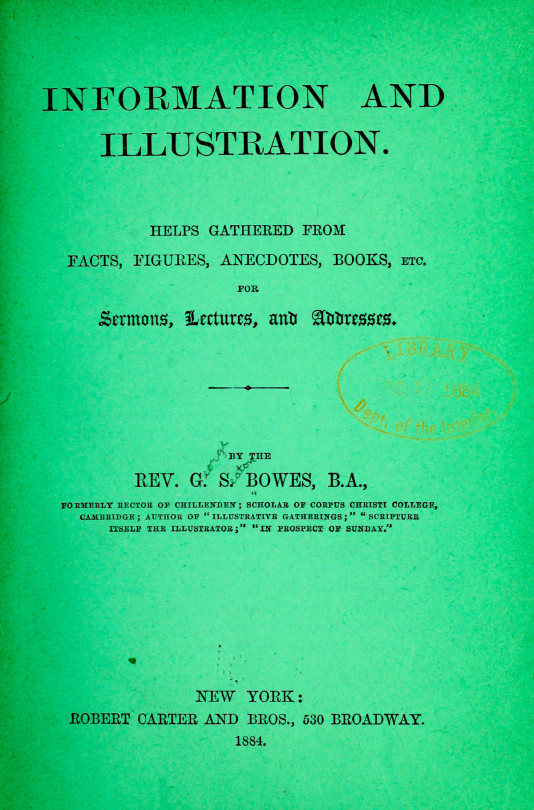

If you'd like an essay-formatted version of this post to read or share, here's a link to it on pluralistic.net, my surveillance-free, ad-free, tracker-free blog:
https://pluralistic.net/2024/12/07/great-kepplers-ghost/art-adjacent

Part one
Part two
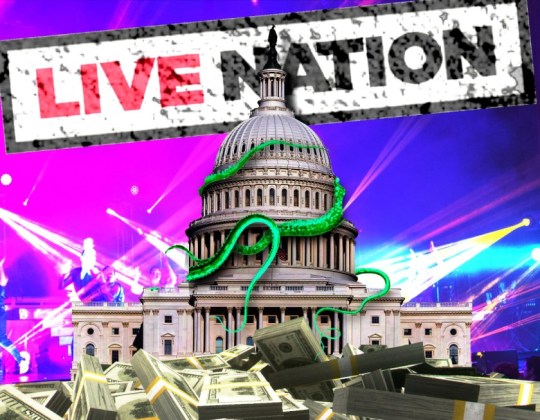
Live Nation/Ticketmaster is buying Congress
I had a lot of fun scouring Victorian woodcuts for cool tentacles to add to this image. The garish concert lights in the background were a fun find – I was halfway through using them when I realized that the image came from my old pal Matt Biddulph, who has many claims to fame, but my favorite is that he once sarcastically called the area in Hackney where some tech startups were clustered "Silicon Roundabout" and then experienced the monkey's paw curse of having the government turn this into an official designation.
https://pluralistic.net/2024/04/30/nix-fix-the-tix/#something-must-be-done-there-we-did-something
(Image: Matt Biddulph, CC BY-SA 2.0; Flying Logos, CC BY-SA 4.0; modified)
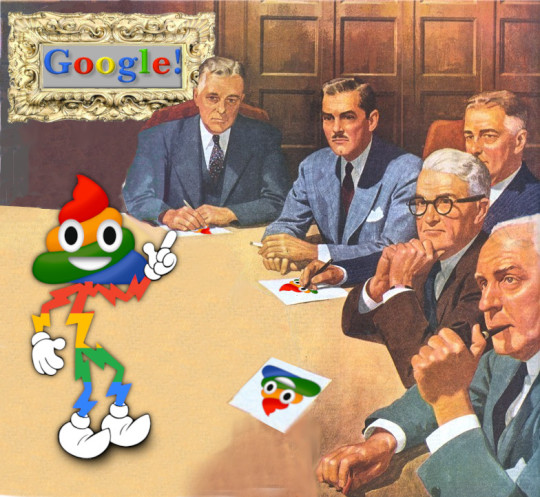
The specific process by which Google enshittified its search
Around April, I realized I needed a visual signifier for "enshittified Google" – I created a cartoon mascot with the head of a poop emoji, colored in the original Google logo colors. I put him into "The Junior Partner Speaks," an old ad for Pacific Woolens and Worsteds, which I've since used several times:
https://craphound.com/images/juniorpartner.jpg
I'm very fond of using the homely old original Google logo as a way to differentiate pre-enshittificatory Google from modern, enshittocene Google.
https://pluralistic.net/2024/04/24/naming-names/#prabhakar-raghavan
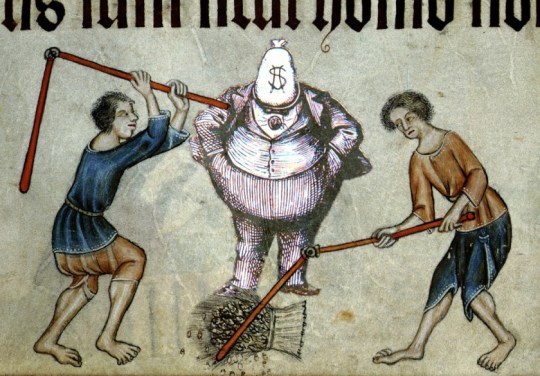
Podcasting "Capitalists Hate Capitalism"
Real Gilded Age corruption-heads will instantly recognize the editorial cartoon image of Boss Tweed as a suited figure with a sack of money for a head; his body language is impeccable, conveying a sneering disregard for decency and others' wellbeing. He works very well inserted into this tapestry of feudal peasants threshing grain.
https://pluralistic.net/2024/04/18/in-extremis-veritas/#the-winnah

No, "convenience" isn't the problem
It's stupidly, unnecessarily hard to find hi-rez scans of Rube Goldberg cartoons online, but this one is perfect and it was a delight to lovingly crop out all its little details. Throw in Cryteria's HAL 9000 and a Matrix code waterfall and you've got a perfect image of the complex, hostile traps of digital systems.
https://pluralistic.net/2024/04/12/give-me-convenience/#or-give-me-death

The unexpected upside of global monopoly capitalism
This one's pretty subtle! I mostly just added the monocle, mustache and top-hat to the fallen head of Goliath in Bosse's 17th century engraving of the triumphant David. The planet Earth in David's sling is a NASA image and thus in the public domain.
https://pluralistic.net/2024/04/10/an-injury-to-one/#is-an-injury-to-all

How to shatter the class solidarity of the ruling class
Goodness, but "canceled" is a tedious cliche. If you must describe someone being ejected from polite society, please consider the far more delightful "defenestrated," not least because the many paintings and etchings of The Defenestration of Prague gives us a lot of public domain visual material to work with when illustrating such events.
https://pluralistic.net/2024/04/08/money-talks/#bullshit-walks
(Image: KMJ, CC BY-SA 3.0, modified)
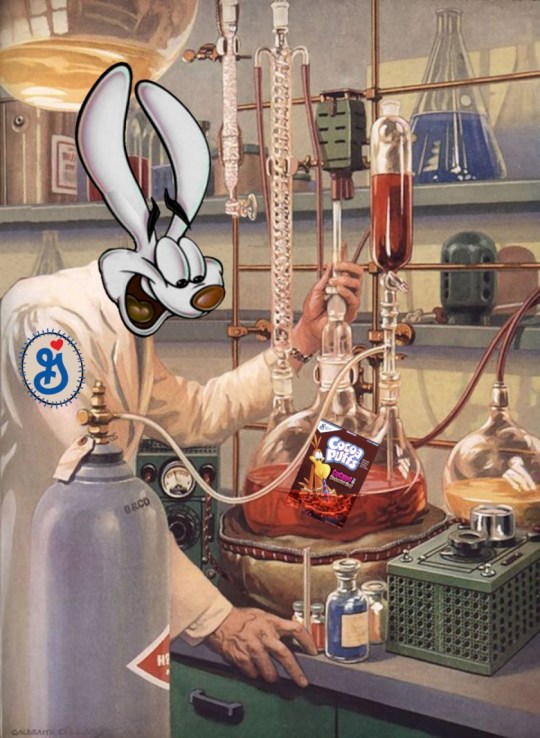
General Mills and cheaply bought "dietitians" co-opted the anti-diet movement
The minute I saw this unsourced midcentury commercial illustration of a scientist working in a chem lab, I knew I'd get a lot of mileage out of it; I spent a long flight productively slicing it onto layers so that I could replace his head and put arbitrary objects in his flask:
https://craphound.com/images/labflask.jpg
I've used him before, but putting the Trix rabbit's head on him and sticking a box of Cocoa Puffs in the flask worked great.
https://pluralistic.net/2024/04/05/corrupt-for-cocoa-puffs/#flood-the-zone-with-shit

Too big to care
I spent the whole flight to SXSW last year slicing up a super hi-rez (10,000px wide!) image of Hieronymus Bosch's "Garden of Earthly Delights," slicing out individual demons, with special attention to the hoof-footed, anus-baring demon in a hat with a whole secret demonic clubhouse in its rectal cavity. At the end of that flight, I had a very funny conversation with my perplexed seatmate, who was dying to know what the actual fuck I was working on.
The background here is made up of desaturated, magnified brushstrokes from Van Gogh's "Starry Night."
https://pluralistic.net/2024/04/04/teach-me-how-to-shruggie/#kagi
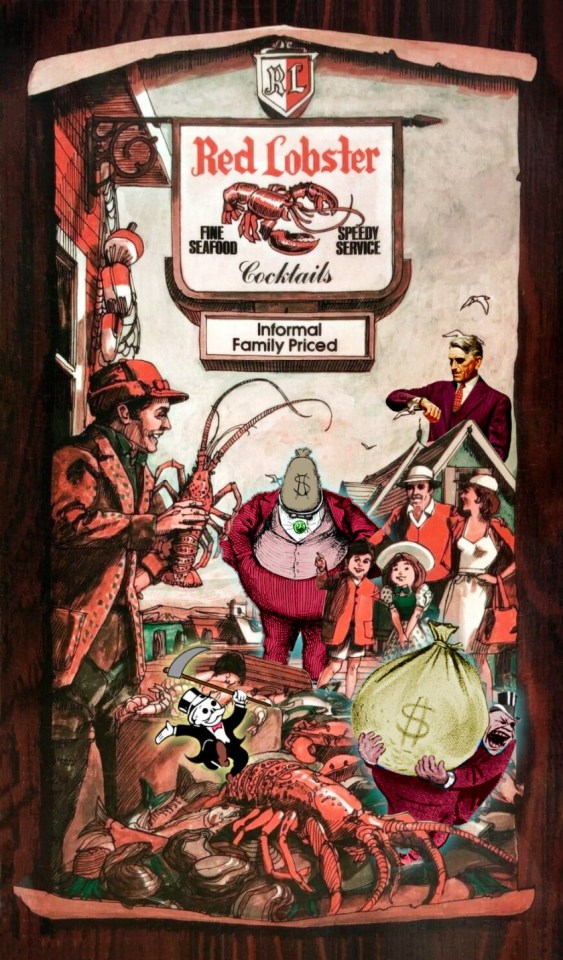
Red Lobster was killed by private equity, not Endless Shrimp
I inserted a rogue's gallery of "evil boss types" from various editorial cartoons into this vintage Red Lobster ad, including Boss Tweed, an impatient guy from a midcentury John Falter commercial illustration, possibly for a radio station (?) and a William Gropper sketch for a cartoon making fun of the business lobby's opposition to the New Deal.
https://pluralistic.net/2024/05/23/spineless/#invertebrates

You were promised a jetpack by liars
The newsie with the great grin makes a reappearance in this one, beneath a jetpack flyer taken from a 1928 Amazing Stories cover by R Frank Paul. The control panel is one of several midcentury electronics consoles I've spent idle hours cropping out (this one comes from a Schlitz ad depicting a HAM radio enthusiast). The hypnotic head is from the October, 1953 cover of Doll-Man, likely by Reed Crandall. I started playing around with halftoning with this one, on the background, as a way of hiding the JPEG artifacts that emerged when I uprezzed small source images. It worked really well.
https://pluralistic.net/2024/05/17/fake-it-until-you-dont-make-it/#twenty-one-seconds

AI "art" and uncanniness
I was so happy with how the extra fingers on this Victorian woodcut of a hand on a Oujia board planchette came out. And the green tinting worked perfectly with the Code Waterfall background.
https://pluralistic.net/2024/05/13/spooky-action-at-a-close-up/#invisible-hand
Part four
#art#collages#public domain#creative commons#cc#fair use#copyfight#visual communications#illustration#pluralistic illustrations 2024
33 notes
·
View notes
Text
Lakinza: Your Guide to an Effective Korean Skincare Routine
In the realm of skincare, the Korean Skincare Routine has garnered global acclaim for its effectiveness and thorough approach. Lakinza, a leading name in skincare, offers a comprehensive guide to mastering the Korean Skincare Routine, ensuring you achieve flawless, radiant skin. Whether you’re new to this routine or looking to refine your existing regimen, Lakinza provides the tools and knowledge needed for an optimal skincare experience.
The Fundamentals of the Korean Skincare Routine
The Korean Skincare Routine is celebrated for its multi-step approach, which prioritizes hydration, protection, and targeted treatment. Lakinza’s guide to the Korean Skincare Routine emphasizes the importance of each step in achieving and maintaining healthy skin. This routine involves a series of steps designed to cleanse, exfoliate, tone, and nourish, ensuring that your skin remains balanced and glowing.
Step-by-Step Process of the Lakinza Korean Skincare Routine
Lakinza’s Korean Skincare Routine involves several crucial steps:
Double Cleansing: Begin with Lakinza’s oil-based cleanser to remove makeup and impurities, followed by a water-based cleanser to thoroughly cleanse your skin. This step is essential in the Korean Skincare Routine to ensure that your skin is completely clean and prepped for further treatment.
Exfoliation: Exfoliation is a key component of the Korean Skincare Routine, and Lakinza provides gentle exfoliators that help to slough off dead skin cells. This step enhances the effectiveness of subsequent products and promotes a smoother, more radiant complexion.
Toning: Lakinza’s hydrating toners are formulated to balance your skin’s pH and provide an additional layer of hydration. Toning is a vital part of the Korean Skincare Routine, as it prepares your skin to better absorb the products that follow.
Essences and Serums: In the Korean Skincare Routine, essences and serums are used to deliver concentrated active ingredients directly to your skin. Lakinza offers a range of essences and serums designed to address specific concerns, such as brightening, anti-aging, and deep hydration.
Moisturizing: To lock in moisture and keep your skin hydrated throughout the day, Lakinza’s moisturizers are an integral part of the Korean Skincare Routine. Proper moisturizing helps maintain skin elasticity and radiance.
Sun Protection: The final step in the Korean Skincare Routine is sun protection. Lakinza’s sunscreens provide essential protection from harmful UV rays, safeguarding your skin from premature aging and sun damage.
Why Choose Lakinza’s Korean Skincare Routine?
Lakinza’s Korean Skincare Routine stands out due to its commitment to quality and innovation. Each product is meticulously formulated to deliver maximum benefits, ensuring that your skincare routine is both effective and enjoyable. By following Lakinza’s guide, you can achieve a radiant complexion and maintain long-term skin health.
Conclusion
Embrace the transformative power of the Korean Skincare Routine with Lakinza as your guide. By incorporating Lakinza’s expertly crafted products into your daily regimen, you can elevate your skincare routine to new heights, achieving the glowing, healthy skin you’ve always desired. Discover the perfect Korean Skincare Routine with Lakinza and enjoy the benefits of radiant, well-nourished skin.
2 notes
·
View notes
Text
Links Roundup
The interwebs had so many interesting things to read this week! Here’s a links roundup of a few.
Hurricanes Becoming So Strong That New Category Needed, Study Says
Where else would we start but at The Guardian, with an article about how much bigger and more intense the biggest, most intense hurricanes (and other cyclones) are becoming. You might call it doom and gloom, but the climate–adjacent scientist in me finds some weird satisfaction in seeing that, yes, retaining extra energy within the climate system because we’ve overinsulated it by adding extra greenhouse gas to the atmosphere is having spectacular effects. Honestly, we need to get our act together about reducing our greenhouse gas emissions to net zero ASAP (40 years ago would have been better).
Should More British Homes Be Built Using Straw?
The BBC website had an interesting article about adding straw–packed panels to the exteriors of buildings (generally as they’re being newly constructed, given the size constraints) to improve their insulation. The straw is packed so tight that it’s fire resistant but not so tight that it doesn’t trap air inside the stuffing, thus serving effectively as insulation, vastly reducing how much you need to heat or cool a building. At the moment, here in Germany, they use thick slabs of Styrofoam, which release horrendously toxic fumes if the building catches on fire. Straw sounds like an interesting, non–toxic, sustainable alternative, especially if you consider how much waste straw is generated every time crops like wheat, rye, and even oilseed rape (Canola) are harvested. The main catch is that production of the panels would need to be scaled up quickly enough to matter in our fight against further climate change by reducing the amount of energy needed to keep buildings at a comfortable temperature.
A US Engineer Had a Shocking Plan to Improve the Climate – Burn All Coal on Earth
This article, also on the BBC website, is about the opposite of trying to save energy, and it’s a quick history of our attitude toward anthropogenic global warming. Turns out, the sort of people who don’t want to admit it’s real today were the sort of people who used to think it would be great to burn all the fossil fuels to take the edge of the chillier aspects of climate. Bonkers. These were probably also the people who liked to think that adding carbon dioxide to the atmosphere would totally boost plant growth, and therefore crop yields, on a major scale. Also bonkers.
Can Slowing Down Save the Planet?
The New Yorker published an interesting review of the book Slow Down: The Degrowth Manifesto, in which the Marxist philosopher Kohei Saito lays out the case for “degrowth communism”. He argues that green capitalism won’t be enough to save the planet—and us. It just looks good from a certain vantage point right now because it pushes the environmental and social costs of resource extraction and good production into the Global South. This allows consumers in the Global North to remain blissfully ignorant of the damage they’re (we’re) doing with their (our) unsustainable lifestyles and obsession with continuous economic growth.
How Craftivism Is Powering 'Gentle Protest' for Climate
Back to the BBC for a fun article about “craftivism”. I’d never thought about this before, but it’s actually a thing that has touched almost all of our lives, even if we’re all thumbs with a terrible sense of aesthetics. Who hasn’t walked past a street pole or statue encased in guerilla knitwear? Even I knitted a pussyhat to wear to an anti–Trump demo on inauguration day (although I didn’t knit a pink one because I would rather die than wear pink, except utterly ironically). And—although perhaps I’m revealing my age here—who hasn’t seen at least a few squares of an AIDS quilt? On the whole, I think it’s good that people put their crafting skills to good political use. Otherwise—and this may be an unpopular opinion—our need to continually craft is just an extension of our unsustainable overproduction and overconsumption of goods. Everyone I know who knits (including myself) has already made more sweaters, hats, scarves, socks, and baby blankets than they can wear out in a lifetime and yet we keep on knitting.
A Big Idea for Small Farms: How to Link Agriculture, Nutrition and Public Health
NPR had a great article that fits with our current podcast episode on regenerative farming with Solarpunk Farms. A literally existential crisis that we’re currently failing to tackle is that of how we grow food. The whole agricultural system is messed up from top to bottom. Food’s too cheap (and many people aren’t paid enough to be able to pay the real price of food, which is a whole other enormous issue). Because of this, farmers are pissed off and dependent upon subsidies from the governments they’d increasingly like to overthrow. Meanwhile, they’re frantically farming so intensively to try to bring in enough income that they’re destroying what’s left of our natural world. Their farming practices are degrading soils and polluting our air and waterways with fertilizers and petrochemical pesticides, destroying adjacent ecosystems and driving numerous species of plants and animals (including insects and other key invertebrates) to extinction. Related to this, we’re eating too much of the wrong stuff (meat, highly processed foods) and not enough of the rights stuff (fruits, nuts, seeds, and vegetables). Enter the solution: nutrition incentive programs that make it possible for people with lower incomes to obtain fruits and vegetables from smaller, regenerative farms. It’s a win for public health, a win for fruit and vegetable farming, which isn’t subsidized the way corn, soy, and wheat farming is, and it’s a win for the small percentage of food producers fighting not to be swallowed up by the Big Food companies who’ve all but monopolized the production of the food we eat.
Tractor Chaos, Neo-Nazis and a Flatlining Economy: Why Has Germany Lost the Plot?
Having started at The Guardian, we’ll bring things full circle and end there with a look at the situation here in Germany. Lots of us are increasingly concerned about the rise of the far right and... perhaps still flying under a lot of people’s radar... that angry farmers are going to end up ushering in the Fourth Reich. The op–ed says it all, while trying to maintain a sense of humor about it. As with so much else in the news these days, it makes you want to scream that we have more important things to be doing right now—that matter for the survival of billions of people—than withdraw into the hermit crab shell of authoritarianism. Their easy answers and general denial of the problems that need solving will only make life even more miserable for most people and allow all our existential problems, like widening wealth inequality, environmental devastation, and increasingly catastrophic climate change, to escalate even further before we begin dealing with them.
Sci_Burst
To end on a happier note, here’s a shout out about Sci_Burst, a fun podcast from Australia about “science, popular culture, and entertainment”. They even have an episode on solarpunk. If you’re all caught up with us (including with all the extras on our YouTube channel), our feelings won’t be hurt if you give them a listen. 😊
3 notes
·
View notes